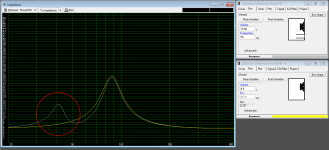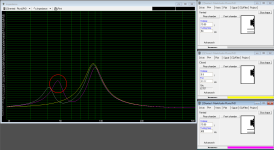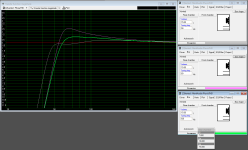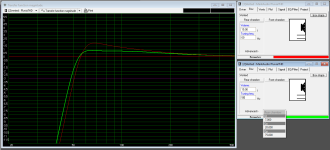Hi,
I am a newbie in DIY Audio. I have a background in electrical engineering and am a musician.
I am currently designing my first speaker. It will be a stereo (dual driver) full-range setup with two Mark Audio Pluvia 7.2 HDs.
Playing around in WinISD for the first time, I think a vented 30 L (net) enclosure tuned to 50 Hz would work quite well.
Now, I need to decide the diameter of the ports. I was thinking two ports? I really have no idea what I am doing here and help would be appreciated. I am aware that larger ports require longer tubing but they reduce air velocity that might otherwise cause chuffing.
Running at 20W system power (also, not sure if this is a reasonable value or not so this is not fixed or conclusive), anything above 50mm seems to be ok, but again I have no idea.
Thanks in advance,
Arlo
I am a newbie in DIY Audio. I have a background in electrical engineering and am a musician.
I am currently designing my first speaker. It will be a stereo (dual driver) full-range setup with two Mark Audio Pluvia 7.2 HDs.
Playing around in WinISD for the first time, I think a vented 30 L (net) enclosure tuned to 50 Hz would work quite well.
Now, I need to decide the diameter of the ports. I was thinking two ports? I really have no idea what I am doing here and help would be appreciated. I am aware that larger ports require longer tubing but they reduce air velocity that might otherwise cause chuffing.
Running at 20W system power (also, not sure if this is a reasonable value or not so this is not fixed or conclusive), anything above 50mm seems to be ok, but again I have no idea.
Thanks in advance,
Arlo
Hi!
I simulated this speaker in WinISD using 30 liters with tuning at 50Hz.
The result is not good - it will be a boomy box at 50Hz and with high group delay (not good).
Does your simulation look similar to mine? Just double checking.
See below.
Some questions:
-What is the frequency response do you expect to have?
-What is the SPL you plan to achieve?
-Any special reason to choose this speaker?
Why not explore other options? If keeping this speaker, maybe a smaller box or a lower tuning frequency.
Tuning at 38Hz with same volume will remove this boomy effect. Boomy box is something to avoid.
Another option is install a 8" subwoofer in this enclosure building a 2-Way system for example.
Regarding to the port size, you have to choose a length that fits in your enclosure, choose a port area to keep air velocity ideally below 17m/s (at maximum power - you must set the power in WinISD), and make sure port resonance is not too low in such a way that it cannot be damped.
About air velocity it is not something written in a stone. It all depends on how much power you really have in the frequency range of the port. If you system has 20W (20Hz to 20kHz), but only 7W will be in the frequency port range, then the power to observe the air velocity is 7W and not 20W. In very low end tuning such as 25Hz, for example, the air velocity to observe is more in the audio region, not exactly the maximum at 25Hz. I'm just saying there are flexibilities to explore here.


I simulated this speaker in WinISD using 30 liters with tuning at 50Hz.
The result is not good - it will be a boomy box at 50Hz and with high group delay (not good).
Does your simulation look similar to mine? Just double checking.
See below.
Some questions:
-What is the frequency response do you expect to have?
-What is the SPL you plan to achieve?
-Any special reason to choose this speaker?
Why not explore other options? If keeping this speaker, maybe a smaller box or a lower tuning frequency.
Tuning at 38Hz with same volume will remove this boomy effect. Boomy box is something to avoid.
Another option is install a 8" subwoofer in this enclosure building a 2-Way system for example.
Regarding to the port size, you have to choose a length that fits in your enclosure, choose a port area to keep air velocity ideally below 17m/s (at maximum power - you must set the power in WinISD), and make sure port resonance is not too low in such a way that it cannot be damped.
About air velocity it is not something written in a stone. It all depends on how much power you really have in the frequency range of the port. If you system has 20W (20Hz to 20kHz), but only 7W will be in the frequency port range, then the power to observe the air velocity is 7W and not 20W. In very low end tuning such as 25Hz, for example, the air velocity to observe is more in the audio region, not exactly the maximum at 25Hz. I'm just saying there are flexibilities to explore here.
How's about a MicroTower: https://www.diyaudio.com/community/threads/microtower-bipolar-ml-tl-for-chr-70-or-el70.148901/I am currently designing my first speaker. It will be a stereo (dual driver) full-range setup with two Mark Audio Pluvia 7.2 HDs.
https://frugal-phile.com/boxlib/P10free/microTower-maps-020615.pdf
Hi, reading your post again - So when you say dual, you mean that each enclosure will have 2 drivers?It will be a stereo (dual driver) full-range setup with two Mark Audio Pluvia 7.2 HDs.
If yes, then 30liter and 50Hz tuning is ok. My first simulation I did it with just 1 driver.
With 20W, you can use 3" port with length of 15cm.
Air velocity will be below 13m/s which is ok!
This will be a loudspeaker limited to 42Hz @ -3dB.
If this is your expectation, ok.
The sims look really ugly.
Iput P7HD in 9 litre, have looked at 11 but disn’t really like it.
A regular vented box could likely be a touch larger but 30 itres is likely too big.
When simming double the Va of a single P7HD. You want a nice smooth roll-off and i prefer a gentler slope of the roll-off.
You may want to try filtering out the top of one of the drivers (note: in the microTower Castles this is done acoustically).
http://www.planet10-hifi.com/downloads/Dual-Driver-Wiring.pdf
dave
Iput P7HD in 9 litre, have looked at 11 but disn’t really like it.
A regular vented box could likely be a touch larger but 30 itres is likely too big.
When simming double the Va of a single P7HD. You want a nice smooth roll-off and i prefer a gentler slope of the roll-off.
You may want to try filtering out the top of one of the drivers (note: in the microTower Castles this is done acoustically).
http://www.planet10-hifi.com/downloads/Dual-Driver-Wiring.pdf
dave
I'd not use this speaker for bass, even in a dual configuration - why limit the listening experience to 42Hz and up?
If he wants to use this full range speaker, I'd use just one with a separate small sealed box (4 liter) behind it and cross it over above 100 or 200Hz, for example.
He can crossover at 6dB/oct - very easy and non critical.
Then, I'd install a 8" subwoofer to drive 200Hz and below (GRS 8SW-4HE for example) tuned around 26Hz.
This system would respond frequencies below 30Hz. Much better.
If he wants to use this full range speaker, I'd use just one with a separate small sealed box (4 liter) behind it and cross it over above 100 or 200Hz, for example.
He can crossover at 6dB/oct - very easy and non critical.
Then, I'd install a 8" subwoofer to drive 200Hz and below (GRS 8SW-4HE for example) tuned around 26Hz.
This system would respond frequencies below 30Hz. Much better.
why limit the listening experience to 42Hz and up?
Pretty much like most multi-ways. This is a red herring.
If after your build you still want more bottom add woofers or sub woofers. If you want more/lower extention, Twin FH3 or Twin Pensils.
dave
dual driver T/S max flat alignment:
Vented net volume (Vb) (L) = 20*4.4227*0.6'^3.3 = 16.39 L x 2 = 32.78 L
(Ft^3 = (Vb)/~28.31685)
Vented box tuning (Fb) (Hz) = 0.42*72.5494*0.6'^-0.96 = 49.76 Hz
F3 (Hz) = 72.5494*0.28*0.6'^-1.4 = 41.53 Hz
(Qts'): (Qts) + any added series resistance (Rs)
Vented net volume (Vb) (L) = 20*4.4227*0.6'^3.3 = 16.39 L x 2 = 32.78 L
(Ft^3 = (Vb)/~28.31685)
Vented box tuning (Fb) (Hz) = 0.42*72.5494*0.6'^-0.96 = 49.76 Hz
F3 (Hz) = 72.5494*0.28*0.6'^-1.4 = 41.53 Hz
(Qts'): (Qts) + any added series resistance (Rs)
Last edited:
+1 Yeah, the way I calc'd it I get ~135 Hz/1st and prefer to roll off the second one ~ at its Fhm = 2*Fs/Qts'.I'd not use this speaker for bass, even in a dual configuration
If he wants to use this full range speaker, I'd use just one with a separate small sealed box (4 liter) behind it and cross it over above 100 or 200Hz, for example.
He can crossover at 6dB/oct - very easy and non critical.
And WinIsd leakage (Ql) is set to 10 which is impossible in real life with a vented enclosure.
Set leakage to 7 so the upward Q seen in post #4 wont be so horrible at cutoff.
The resonant frequency of these drivers is 72 Hz so tuning wont be more than 3 to 10 Hz above/below that.
And it is already telling you the end of the road is = 72 Hz in real life.
Being the data sheet dont show more than 100 Hz. pretty normal for a 72 Hz Fs 4" speaker.
2x 4" drivers with no crossover will cancel and comb in the vertical no different than a 8" driver.
Might as well just use a 8" fullrange and get a speaker that actually does bass with a Fs around 35 to 45 Hz.
In Winisd when you open the driver it will recommend a proper alignment.
Just use that since tuning 20 Hz below a driver Fs doesnt sound good to me.
Qts seems to be around .58 or basically 6.
Pretty weak magnet and will be a somewhat big box for the size.
4mm xmax seems like a fantasy. With such a weak magnet.
Likely the same old 1mm like a zillion other 4" drivers.
The point? the speakers will unload around 3 watts with 2 maybe 7 watts.
The port doesnt have to be very big. Since velocity will be low regardless with low power
As mentioned since 2x drivers will just cancel high frequency anyways, just use a 8"
Or do a 2 way with a woofer for bass. Since Fs is 72 Hz it is basically a midrange that should be crossed at 200 Hz min.
Set leakage to 7 so the upward Q seen in post #4 wont be so horrible at cutoff.
The resonant frequency of these drivers is 72 Hz so tuning wont be more than 3 to 10 Hz above/below that.
And it is already telling you the end of the road is = 72 Hz in real life.
Being the data sheet dont show more than 100 Hz. pretty normal for a 72 Hz Fs 4" speaker.
2x 4" drivers with no crossover will cancel and comb in the vertical no different than a 8" driver.
Might as well just use a 8" fullrange and get a speaker that actually does bass with a Fs around 35 to 45 Hz.
In Winisd when you open the driver it will recommend a proper alignment.
Just use that since tuning 20 Hz below a driver Fs doesnt sound good to me.
Qts seems to be around .58 or basically 6.
Pretty weak magnet and will be a somewhat big box for the size.
4mm xmax seems like a fantasy. With such a weak magnet.
Likely the same old 1mm like a zillion other 4" drivers.
The point? the speakers will unload around 3 watts with 2 maybe 7 watts.
The port doesnt have to be very big. Since velocity will be low regardless with low power
As mentioned since 2x drivers will just cancel high frequency anyways, just use a 8"
Or do a 2 way with a woofer for bass. Since Fs is 72 Hz it is basically a midrange that should be crossed at 200 Hz min.
Last edited:
Basically a port has no wires to it.
Its energy comes from the speaker. If the lower impedance bump on a vented alignment falls far far below the upper impedance curve.
Basically tells you if the speaker actually does or doesnt have enough magnet to support a low port tuning.
Otherwise it just looses control and the port wont be efficient or have any energy regardless to make the pretty graph actually feasible.
Usually with a weak magnet and making a perfect no lose cabinet with a QL of 10 like winisd.
Even in a perfect impossible box. You will see that strange inverted peak behavior in post #4
Basically no control. Tuned to low or box too big. Speaker in real life cant provide enough energy to such a low tuning
or large long vent. And if the box is large to remove the high Q from a .6 Qts speaker.
The cone has no control. Distortion will be high with low power with a big box.
You can match the impedance bump vented to a sealed .707 to see how big the box can actually go.
Then see if the magnet actually has any ooophhhh to provide energy for a low tuning.
This driver is .6 Qts so I can already tell from what is posted. Not enough control to make a port work well much below Fs.
The port does not have to be very big. The speaker will give up the ghost below 72 Hz with about 3 to 6 watts.
Maybe ill look at it in sim should be entertaining.
Basically usually with a weak magnet or high Qts once you get the impedance curve to a point where the port would actually have energy
from the speaker. Being a high Qts speaker the transfer function would have a massive peak.
So you just lower the tuning till you get something reasonable. Which will still be high Q.
But hold to the very very basics. A "Vented" enclosure will have slightly more bass than Sealed.
The important part = " slightly" more bass than sealed. Not magical fantasy that a 72 Hz Fs speaker will do 40 Hz.
Again no wires to a port....it is just a velocity ramp that slightly resembles the complicated waveforms a speaker can actually produce.
With a magnet, not a poof poof of fake air.
Its energy comes from the speaker. If the lower impedance bump on a vented alignment falls far far below the upper impedance curve.
Basically tells you if the speaker actually does or doesnt have enough magnet to support a low port tuning.
Otherwise it just looses control and the port wont be efficient or have any energy regardless to make the pretty graph actually feasible.
Usually with a weak magnet and making a perfect no lose cabinet with a QL of 10 like winisd.
Even in a perfect impossible box. You will see that strange inverted peak behavior in post #4
Basically no control. Tuned to low or box too big. Speaker in real life cant provide enough energy to such a low tuning
or large long vent. And if the box is large to remove the high Q from a .6 Qts speaker.
The cone has no control. Distortion will be high with low power with a big box.
You can match the impedance bump vented to a sealed .707 to see how big the box can actually go.
Then see if the magnet actually has any ooophhhh to provide energy for a low tuning.
This driver is .6 Qts so I can already tell from what is posted. Not enough control to make a port work well much below Fs.
The port does not have to be very big. The speaker will give up the ghost below 72 Hz with about 3 to 6 watts.
Maybe ill look at it in sim should be entertaining.
Basically usually with a weak magnet or high Qts once you get the impedance curve to a point where the port would actually have energy
from the speaker. Being a high Qts speaker the transfer function would have a massive peak.
So you just lower the tuning till you get something reasonable. Which will still be high Q.
But hold to the very very basics. A "Vented" enclosure will have slightly more bass than Sealed.
The important part = " slightly" more bass than sealed. Not magical fantasy that a 72 Hz Fs speaker will do 40 Hz.
Again no wires to a port....it is just a velocity ramp that slightly resembles the complicated waveforms a speaker can actually produce.
With a magnet, not a poof poof of fake air.
Last edited:
Being a high Qts speaker the transfer function would have a massive peak.
So you just lower the tuning till you get something reasonable.
........or critically damping the vent. 😉
Last edited by a moderator:
Yes exactly. Very good point.
After looking at sim and the impedance curve showing any control around port tuning.
It follows any normal rule of thumb. Cant really tune much more than 10 Hz below Fs.
Qts being high is very also very High Q in transfer function.
I had to make Qa around 10 or 20 to calm it down to being reasonable.
Basically exactly as GM mentioned you would add damping...and a lot of it.
likely stuff the krap out of it to get Qa to 10 or 20.
After looking at sim and the impedance curve showing any control around port tuning.
It follows any normal rule of thumb. Cant really tune much more than 10 Hz below Fs.
Qts being high is very also very High Q in transfer function.
I had to make Qa around 10 or 20 to calm it down to being reasonable.
Basically exactly as GM mentioned you would add damping...and a lot of it.
likely stuff the krap out of it to get Qa to 10 or 20.

Guess it aint to bad. Yellow is .707 Qtc sealed.
I can match the same upper impedance and control it shows with 15 liters vented.
So 30 liters for 2 drivers makes sense.
Can see impedance is rather low below resonance tuned 50 Hz. Not much control for that port tuning.
I like high Qts sealed the lack of magnet actually could be nice for a tuber. Impedance wise at least
With very high control with .3 or .4 Qts speakers. With high control and whooper magnets impedance shoots up like a rocket.
Its how you know you got control, high impedance around either resonance.

If I raise the tuning to 60 Hz we do get a impedance rise. Not much.
Big effect on transfer function lol. I forgot what picky little devils high Qts speakers are vented.
Funny what 5 to 6 ohms will give you at port output when something is actually happening.
Almost being nitpicky and wasting peoples time.

Can see with green line higher tuning with a major stuffing brings down the Q
Qa at 10 might be a far stretch in real life. Heavily stuffed.
Anyhoo... all I got for single driver high Qts is tricky vented. 15L for 1x driver or 30L for 2x around 55 to 60 Hz tuning/ Fb
Heavy Heavy fill. Maybe plain old 50 Hz was fine it is actual C4 alignment. Drivers get hot then Q come up anyways....
I cant stand high tuning cant believe im mentioning it anyways lol

- Home
- Loudspeakers
- Full Range
- Help choosing ports for dual full-range speaker design